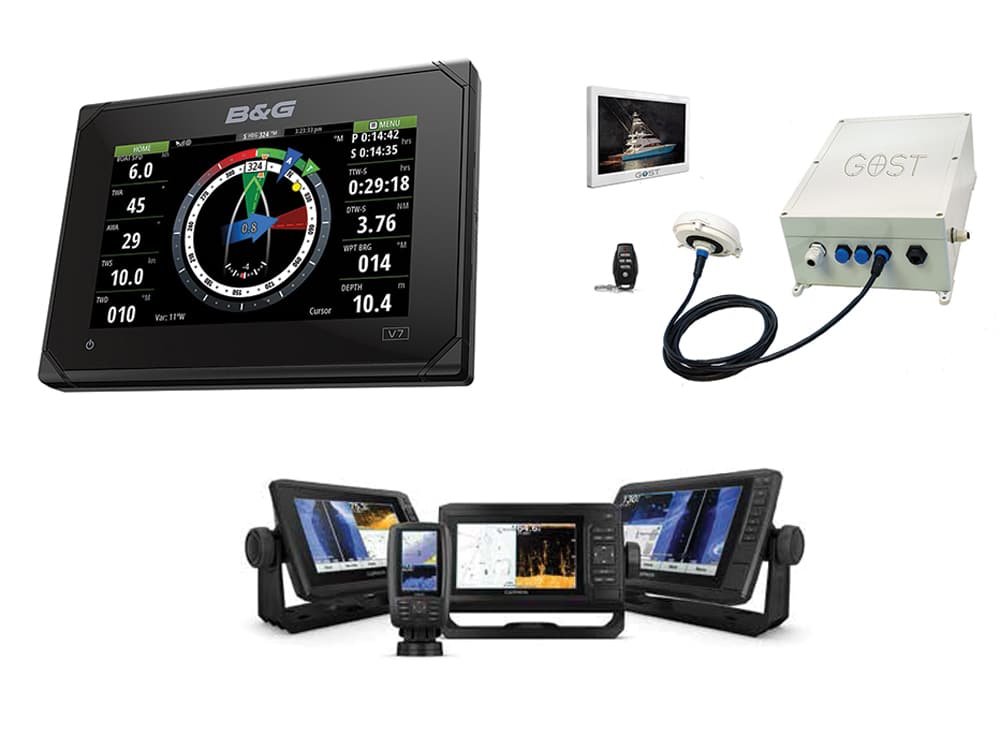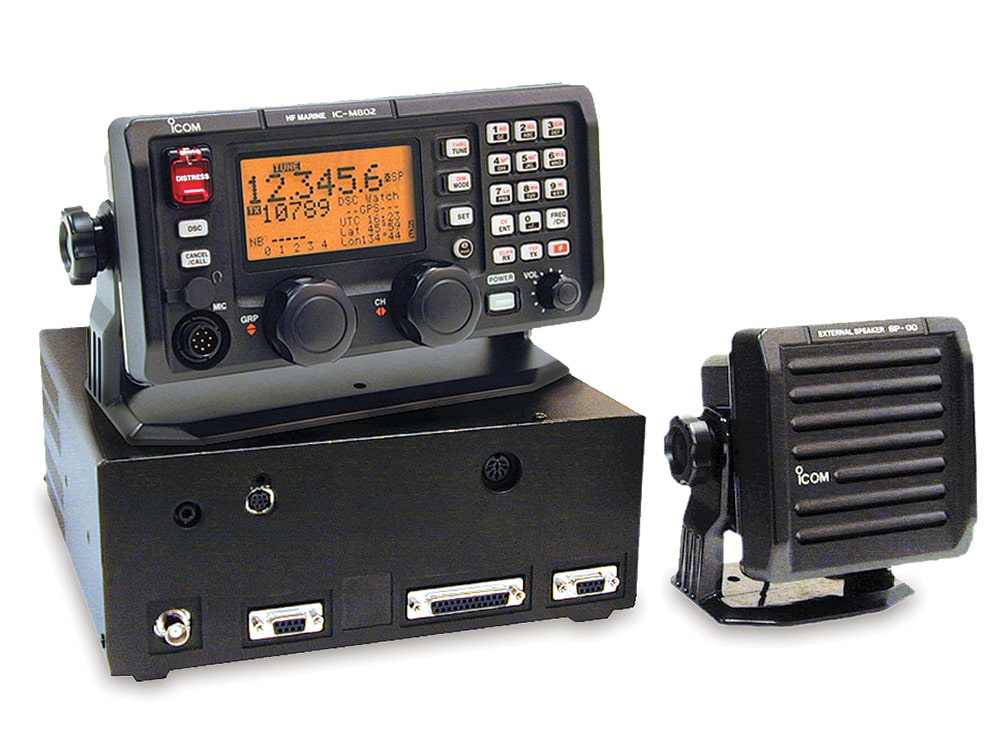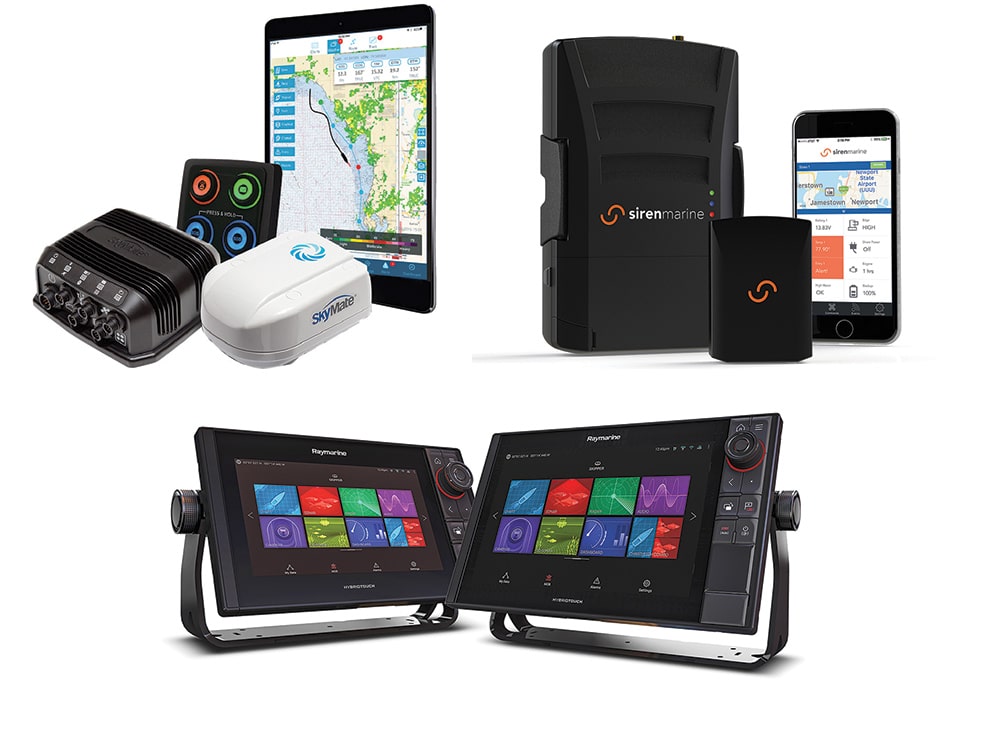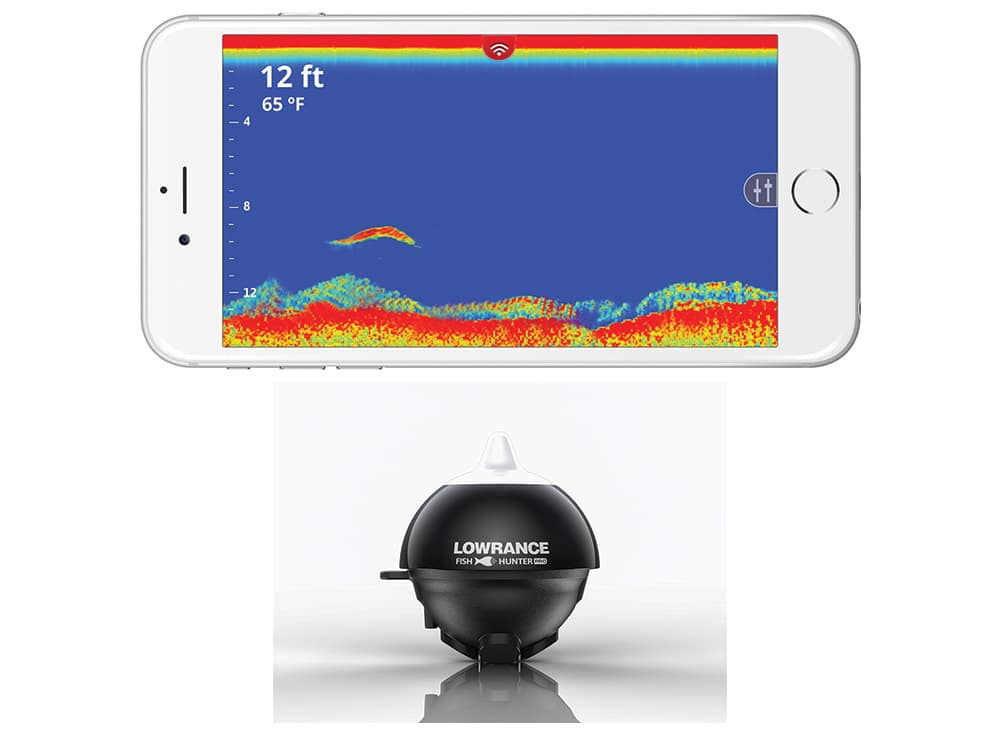
There’s nothing better than taking a front-row seat to watch the evolution of marine electronics. Last fall, I strolled the equipment halls of the National Marine Electronics Association Conference & Expo; walked the docks and crawled through tents at the U.S. Sailboat Show at Annapolis; attended the Fort Lauderdale International Boat Show; and hoofed the cavernous halls at the Marine Equipment Trade Show in Amsterdam to get a handle on 2018’s most interesting new offerings. Read on for a roundup of what I found, presented in alphabetical order by manufacturer.
B&G’s Rollout
B&G has been making headlines for the past several years with its Vulcan series of stand-alone chart plotters that offer navigational capabilities and B&G’s proprietary sailing-specific software, including SailSteer, Sailing Time and Start Line. Now, the U.K.-based marine-electronics manufacturer is offering two refreshed models: the Vulcan 7 ($700) and the Vulcan 9 (from $1,050). Both support B&G Broadband radar systems, which is a first for the Vulcan family. Previously, if sailors wanted the ability to overlay radar on their plotters, they had to purchase a plotter in the Zeus line.
Additionally, B&G unveiled an all-new radar-friendly Vulcan 12 ($2,200) for sailors seeking a big-glass experience. All three Vulcan plotters boast bright, colorful and easy-to-read screens that feature touch-screen-only interfaces and user-friendly software, menus and operating systems.
Radar is key for any serious offshore or poor-visibility sailing, and the Vulcan family took a major step toward becoming a viable one-plotter solution thanks to its ability to interface with B&G’s 3G or 4G Broadband radars. Now, sailors can ping targets up to 36 nautical miles away and see returns overlaid atop cartography and their vessel’s networked GPS position information.

Although B&G’s high-end WTP3 and H5000 systems are designed for hardcore racers, cruising sailors can leverage the sailing-specific features that come aboard Vulcan plotters to reach the next port faster and more efficiently, while also learning more about performance-minded sailing en route. Users can unlock advanced-level features, such as PredictWind weather forecasting, which is great for both offshore and coastal cruising. And skippers who enjoy occasionally blending in with the racing crowd will appreciate the plotters’ countdown and starting-line functionalities.
Additionally, the new Vulcans are all Wi-Fi enabled and can be app-controlled via a tethered wireless device (Android or iOS compatible), and all three models support B&G’s ForwardScan forward-looking sonar, which can lower anxiety levels when nosing into unfamiliar or skinny-water anchorages.
Garmin’s New Plotter Lineup
Garmin is never one to arrive at fall boat shows empty-handed, and this year was no exception as the Kansas City, Kansas-based technology giant unveiled its new line of EchoMap Plus chart plotters, which are available in four screen sizes: 4-inch ($200 to $350), 6-inch ($350 to $550), 7-inch ($650 to $700) and 9-inch ($850 to $1,500). The three larger EchoMap Plus plotters include built-in Wi-Fi connectivity to support Garmin’s new ActiveCaptain application (also available as a smartphone or tablet app from Apple’s App Store or Google Play), which Garmin is billing as a one-stop shop for all chart purchases (or updates), trip planning, software updates and access to the ActiveCaptain Community, among other features.
In addition to supporting chart-plotter functionality, the three larger EchoMap Plus plotters feature Garmin’s SailAssist software, which includes a wind rose, laylines, heading and course-over-ground lines, set and drift information, and apparent- and true-wind angles and speeds. And for any cruisers who enjoy the occasional romp around a racecourse, these new plotters also come with Garmin’s racing-specific features, which include a virtual starting line and various timers.
Finally, the 7- and 9-inch EchoMaps feature Garmin’s keyed-assist touch-screen interface, which gives users customizable one-button shortcuts to their favorite features.
GOST Stands Guard
Global Ocean Security Technologies has helped plenty of owners thwart vessel break-ins or dodge outright theft, and its newest system, dubbed the Apparition, offers an impressive number of bad-guy-stopping technologies. For starters, the black-box system is designed to be buried deep within a larger-size yacht, making it hard or impossible for thieves to find and destroy, and it’s controlled by up to 16 different 5- or 7-inch touch-screen keypads that employ an intuitive graphical user interface. GOST’s Apparition can support up to 192 different sensors, ranging from infrared-beam and deck-pressure sensors to pull sensors, and a companion app (free) immediately notifies an owner, captain or marina manager if there’s an onboard issue.
Additionally, Apparition works with GOST’s other product lines, such as GOST’s Cloak (sold separately), which, once tripped, vaporizes a proprietary glycol solution to fill a cabin or interior space with a dense, escape-thwarting fog. Each system is customized to fit a particular vessel, so set pricing for Apparition is not available.
Icom’s SSB Is Back
Icom has brought a classic technology out of dry dock with the rerelease of the M802 single-sideband radio, which the company says is the only single-sideband radio still available for recreational users. The M802 ($3,420) boasts 150 watts of output power, built-in digital selective calling, a large, easy-to-read LCD display and a maximum of 1,355 channels.
If paired with an optional modem, the M802 can also be used to send or receive email and weather faxes via SSB frequencies. The M802 features a headphone jack on its front face, NMEA 0183 compatibility and input for a GPS receiver (optional), as well as a remote-control microphone that allows users to directly select channels, and — most important — the ability to communicate globally with other SSB users. (Stay tuned to this space for more about this radio in an upcoming issue.)

Mazu’s in Touch
SkyMate’s mazu has been garnering attention and winning boat-show new-product awards with its new mSeries system (about $1,000 for hardware, plus monthly airtime fees that can be affordably “winterized”). The system allows cruisers to send and receive (relatively) small packets of information, such as email, weather (GRIB files and, when available, NOAA weather alerts and Nexrad graphic weather) and SMS communications, globally. Mazu’s mSeries system uses a proprietary compression algorithm to make these data packets as small as possible (read: cost effective) while still enabling sailors to send and receive mission-critical information. While mazu doesn’t provide internet access in the same sense of a high-speed land-based internet connection (you won’t be streaming Game of Thrones offshore), it allows cruisers to access specific pieces of information for significantly lower fees than VSAT or FleetBroadband satellite-communications systems. Rather than using a bulky gyrostabilized dome, mazu is a simple black-box system that connects to SkyMate’s servers via an Iridium satellite connection, which affords a global coverage footprint.
Users can download the free mazu marine app (available from Apple’s App Store), which can be installed on any iPad and used to connect to shore-based cellular and Wi-Fi networks to save money on data fees while coastal cruising. Alternatively, users can access and control the system using any Web browser. However, the app provides additional functionality. Mazu can also be used to send emergency SOS messages to the privately operated GEOS emergency-monitoring network. Buyers should understand that mazu systems are permanently installed (therefore nontransportable) and complement, but never replace, EPIRBs. Finally, users can also upgrade to SkyMate’s optional Sentry vessel-monitoring system, which keeps an unblinking electronic eye on the boat, around the clock.

Raymarine Sings On Key
Raymarine introduced its Axiom line of multifunction displays at the 2017 Miami International Boat Show last February, but those original plotters featured touch-screen-only user interfaces. While this works beautifully in calm seas or at anchor, some sailors have trouble tapping the correct portion of a touch-screen display while heeled over at 30 degrees and slamming through rough seas, so Raymarine’s just-introduced Axiom Pro plotters feature a hybrid touch-screen and hard-key user interface.
Axiom Pro plotters come with 9-, 12– and 16-inch screens, ranging in price from $3,000 to $6,000. They feature optically bonded high-resolution in-plane switching screens that deliver bright colors and wide viewing angles in direct sunlight; high-speed quad-core processors; and built-in 72-channel GNSS/GPS receivers. All three chart plotters also offer two different levels of sonar capability; S models feature a single-channel chirp sonar, while RVX models boast Raymarine’s proprietary RealVision 3D sonar and a 1 kHz chirp sonar.
The Axiom Pros are designed to serve double duty between sailboats and powerboats, and their physical hardware and software make them equally adept on both platforms. For example, all Axiom Pro plotters are NMEA 0183 and NMEA 2000 friendly and rated to IPX6/IPX7 waterproof standards, and they interface with Raymarine’s Quantum solid-state radars and Evolution autopilot systems. Additionally, they work with a wide range of cartography and come bundled with sailing-specific software functionality, such as sail instrument data and wind calculations. An upcoming update to Raymarine’s LightHouse operating system (likely available in early 2018) is expected to include racing-specific features.

Siren Signals Security
Siren Marine’s new Monitor, Track, Control connected-boat system is designed to give owners around-the-clock peace of mind, irrespective of whether they’re relaxing at home or traveling halfway around the world. The MTC system retails for about $600, and requires a $180 annual monitoring-service fee. In return, the system monitors critical vessel information, including high-water and bilge levels, and also provides access to deep-level metrics, such as how much juice the bilge pump has actually been drawing, which is critical for knowing if the pump is dry-cycling or moving water.
The MTC features an internal 56-channel GPS receiver and a Linux processor, which allows users to set geofences and monitor the vessel’s latitude and longitude via a PC or with an app that’s Android- and iOS-friendly. Each MTC also has an internal 3G cellular modem and the ability to monitor different user-selected wired and wireless sensors; should one of these trip, the MTC immediately alerts the vessel’s owners. Finally, users can harness the MTC’s cellular connectivity and processing power to remotely control the main battery and three user-selected systems (such as navigation or cabin lights, or the vessel’s heating and cooling system).








